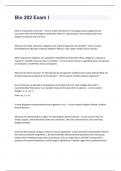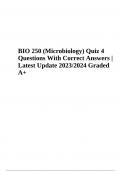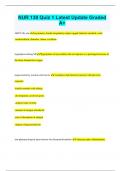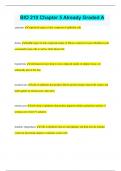Stem cell bio Study guides, Class notes & Summaries
Looking for the best study guides, study notes and summaries about Stem cell bio? On this page you'll find 207 study documents about Stem cell bio.
Page 3 out of 207 results
Sort by

-
BIO 315 Exam 1 Questions and Answers 100% Pass
- Exam (elaborations) • 17 pages • 2024
-
- $12.49
- + learn more
BIO 315 Exam 1 Questions and Answers 100% Pass Humans have 23 pairs of chromosomes. Chromosomes 1-22 are best referred to as ______. a. Centromeres b. Autosomes c. Karyotype d. Nuclei e. Sex chromosomes - Correct Answer ️️ -B How many DNA molecules would be found in a single chromosome? a. 4 b. 10 c. More than 10 d. 1 e. 2 - Correct Answer ️️ -D An alternate form of a gene is called a(n) ________. a. Allele b. Exome c. Genome d. Chromosomes e. mutation - Correct Answer...

-
ONCC EXAM 2024 WITH 100% ACCURATE SOLUTIONS
- Exam (elaborations) • 7 pages • 2024
-
- $12.49
- + learn more
ONCC EXAM 2024 WITH 100% ACCURATE SOLUTIONS A patient has had an allergenic him out of poetic stem cell transplant. How many days after this transplant shut the patient expect to experience neutrophil engraftment. - correct answer 15-20 days A patient is receiving paclitaxel and would like to have a manicure. What instructions should the patient receive? - correct answer Use a non-acetone, polish remover Which of the following task should the nurse ask a patient to perform prior to the ...

-
BIO 202 Arizona State University -Bio 202 Exam I fully solved
- Exam (elaborations) • 9 pages • 2024
- Available in package deal
-
- $14.99
- + learn more
BIO 202 Arizona State University -Bio 202 Exam I fully solved What is a taxonomic hierarchy? - correct answer the process of arranging various organisms into successive levels of the biological classification either in a decreasing or an increasing order from kingdom to species and vice versa. What are the major taxonomic categories into which all organisms are divided? - correct answer Domain(Archaea, Bacteria, Eukarya); Kingdon; Phylum; Class; Order; Family; Genus; Species. Which taxonom...

-
Summary Trends in Stem Cell Biology (NWI-BM073)
- Summary • 12 pages • 2021
- Available in package deal
-
- $6.61
- 4x sold
- + learn more
Written summary of all lectures Stem Cell Biology including paper discussions. Images added for extra clarity.

-
BIO 250 Microbiology Quiz 4 | Questions With Correct Answers 2023/2024 (Latest Update Graded A+)
- Exam (elaborations) • 11 pages • 2023
- Available in package deal
-
- $17.99
- + learn more
BIO 250 Microbiology Quiz 4 | Questions With Correct Answers 2023/2024 (Latest Update Graded A+). Denature proteins when in a 50-95% alcohol-water solution b. Disinfect items soaked in alcohol c. Are skin degerming agents d. At 50% or higher concentrations dissolve cell membrane lipids e. All of the choices are correct Feedback The correct answer is: All of the choices are correct Question8 Incorrect Mark 0.00 out of 5.00 Flag question Question text The reticuloendothelial system Se...
![RAD BIO FINAL EXAM REVIEW QUESTIONS AND ANSWERS, GRADED A+/ VERIFIED.[LATEST EXAM UPDATES]](/docpics/5654342/666f493c53250_5654342_121_171.jpeg)
-
RAD BIO FINAL EXAM REVIEW QUESTIONS AND ANSWERS, GRADED A+/ VERIFIED.[LATEST EXAM UPDATES]
- Exam (elaborations) • 24 pages • 2024
-
- $10.49
- + learn more
RAD BIO FINAL EXAM REVIEW QUESTIONS AND ANSWERS, GRADED A+/ VERIFIED. In 1838, Schneider and Schwann found the basic functional unit of all plant and animal life is the: - - cell Together, under what general body process does anabolism and catabolism fall? - -metabolism What macromolecules in the cell is/are classified as nucleic acids? 1. DNA 2. RNA 3. Lipids 4. Carbohydrates - -1. DNA 2. RNA Of the following, which is NOT an organic molecule of the body? - -water ___ has the dubiou...

-
Medical Terminology: Exam 2 (Chapters 7-10) Solved 100% Correct
- Exam (elaborations) • 62 pages • 2023
- Available in package deal
-
- $14.99
- + learn more
The largest region of the brain is the: cerebellum medulla oblongata brain stem cerebrum - ANSWER-cerebrum The term "psychology" literally means: the process of studying the bumps on the head the process or procedure of the science or study of thoughts the process or procedure of the science or study of the mind the procedure of the science of memory - ANSWER-the process or procedure of the science or study of the mind The area of the brain responsible for respiration, he...

-
NUR 138 Quiz 1 Latest Update Graded A+
- Exam (elaborations) • 4 pages • 2024
- Available in package deal
-
- $8.99
- + learn more
NUR 138 Quiz 1 Latest Update Graded A+ ABCD (E) rule asymmetry, border irregularity (edges ragged, blurred, notched). color variation/black, diameter >6mm, evolution hyperplasia during MI hyperplasia of myocardial cells in response to a prolonged increase in the body demand for oxygen hypersensitivity reaction risk factors -incidence and intensity increase with previous exposure -family member with allergy -development, severity factors -antigen route of entry -amount of an...

-
AP Bio Genetics, RNA, and DNA Practice Exam 110 Questions with Verified Answers,100% CORRECT
- Exam (elaborations) • 28 pages • 2024
-
- $11.49
- + learn more
AP Bio Genetics, RNA, and DNA Practice Exam 110 Questions with Verified Answers In his transformation experiments, what did Griffith observe? a. Mutant mice were resistant to bacterial infections. b. Mixing a heat-killed pathogenic strain of bacteria with a living nonpathogenic strain can convert some of the living cells into the pathogenic form. c. Mixing a heat-killed nonpathogenic strain of bacteria with a living pathogenic strain makes the pathogenic strain nonpathogenic. d. Infecti...

-
BIO 210 Chapter 5 Already Graded A
- Exam (elaborations) • 8 pages • 2024
- Available in package deal
-
- $9.99
- + learn more
BIO 210 Chapter 5 Already Graded A epidermis superficial region of skin composed of epithelial cells dermis middle region of skin composed mainly of fibrous connective tissue (fibroblasts) and occasionally mast cells as well as white blood cells hypodermis subcutaneous layer deep to skin composed mainly of adipose tissue, not technically part of the skin keratinocytes cells in epidermis that produce fibrous protein keratin; dead at the surface and held together by desmosomes when ...

How much did you already spend on Stuvia? Imagine there are plenty more of you out there paying for study notes, but this time YOU are the seller. Ka-ching! Discover all about earning on Stuvia


